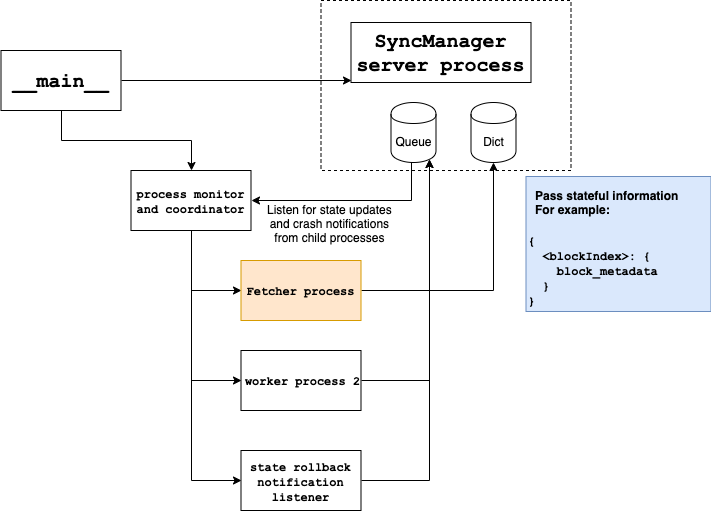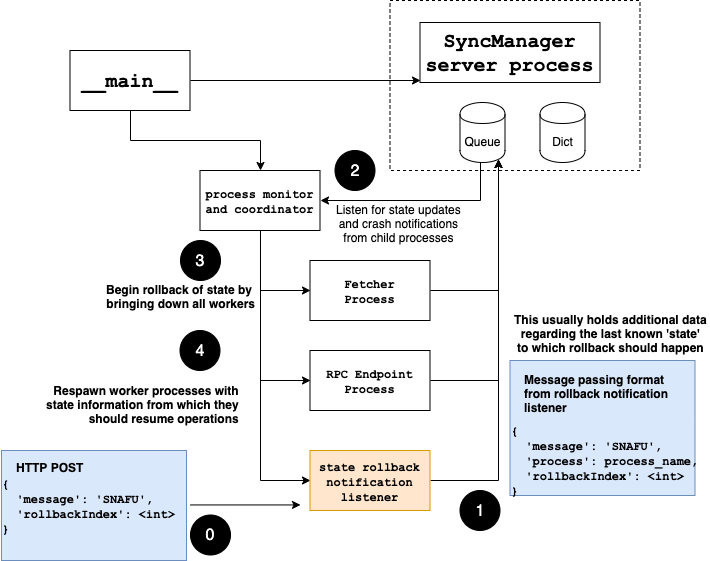This code accompanies a PyCon India 2019 proposal - How we built a State Machine to keep up with a 1200+ Txs/second blockchain protocol
This produces fake "blocks" of data in the following format
{
"hash": "hexstring",
"metaData": "a random string"
}Make a GET call to get a fake block
curl http://localhost:5990/2You will be returned something like this
{
"hash": "b097a1871fb9674f495ffd21e2fee1dfda51ec25fd8f91ddad1b81291f120f6a",
"metaData": "meta8564765"
}This has a few processes running in parallel and they interact and share state via a SyncManager queue and dict.
It fetches fake blocks as described above and stores them in a shared mapping.
This starts a tornado server on localhost, port 5233 which can be queried with a GET request to get the current state of the shared mapping.
{
"processDir": {
"Fetcher1": {
"pid": 4789
},
"Lookout": {
"pid": 4790
},
"Monitor": {
"pid": 4791
}
},
"596": {
"hash": "395e26d58898c579f00bce988a654c8c7a29ee431c38212db40bffbdd02d7103",
"metaData": "meta3718521"
},
"597": {
"hash": "0c249028c7f3fe1ea25bcea5de9b46b1c5ac980aab7561d416f23852b4b9d9e2",
"metaData": "meta5594925"
},
"598": {
"hash": "9c7205bb9b451c12f0c12c8954f206ca5471e601b9a8bd4c9b82e5d9b38be527",
"metaData": "meta3256633"
},
"599": {
"hash": "337430917ba5c0f0031f220355b0fb70d34528923f7468976ca6912762434094",
"metaData": "meta2751058"
},
"600": {
"hash": "257935e24f3f4f6977b6c3b67c5394753807772c31dfd273aa65fb7ed4adca6c",
"metaData": "meta2287915"
},
"601": {
"hash": "be486e57bec1edd48b527d66563a32f411cda69af8e5ac5f4c5e03890c80dd1f",
"metaData": "meta2432676"
}
}This sets up another Tornado server on localhost, port 5232 to which you can POST a request like
{
"message": "SNAFU",
"rollbackIndex": 10
}
This will cause the running processes to be suspended and FetcherProcess will resume fetching from "block" 10 as specified by rollbackIndex
You can use the code in here to generate graphs on memory and CPU usage via statsd and grafana
Follow this StackExchange answer under section graphite-stack & statsd
The shared mapping being updated by the FetcherProcess is pickled to disk in this file during shutdown and restored during start up of core.py
You will see something like this in the logs during the second and subsequent runs of core.py
core-super_manager_init: python3.6: Initialized SyncManager for shared queue and mapping
core-<module>: CacheFileLoad
core-run: Got begin index for fetcher
core-run: 595
and during shutdown,
Fetcher1 Received SIGINT. Going down...
core-shutdown: Shutting down tornado
core-<module>: Main received SIGINT. Going down.
Recieved SIGINT. Shutting down.
core-<module>: Saving to cache file
core-<module>: SyncManager shut down
-
Complete the implementation of
FetcherProcessto pull data from a simulated data source -
Add message passing on crash to
PanicLookoutProcess -
Add stateful information passing to
PanicLookoutProcess -
Add CPU and I/O profiling for some handy statistics

